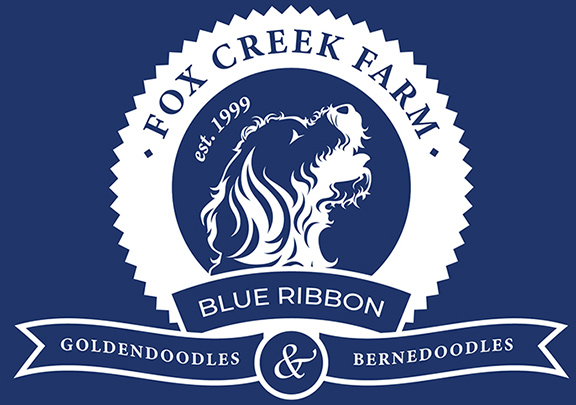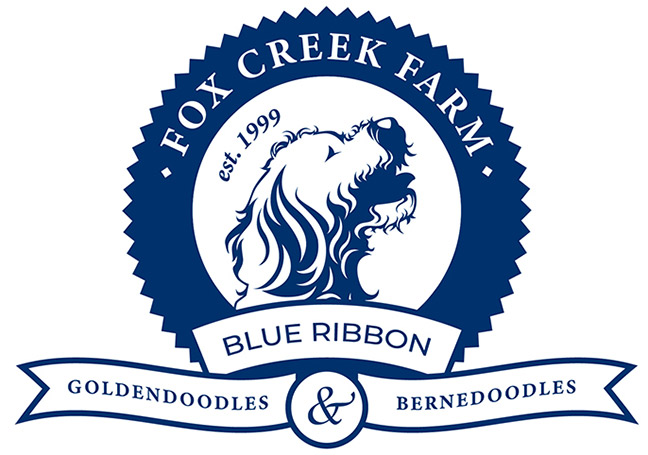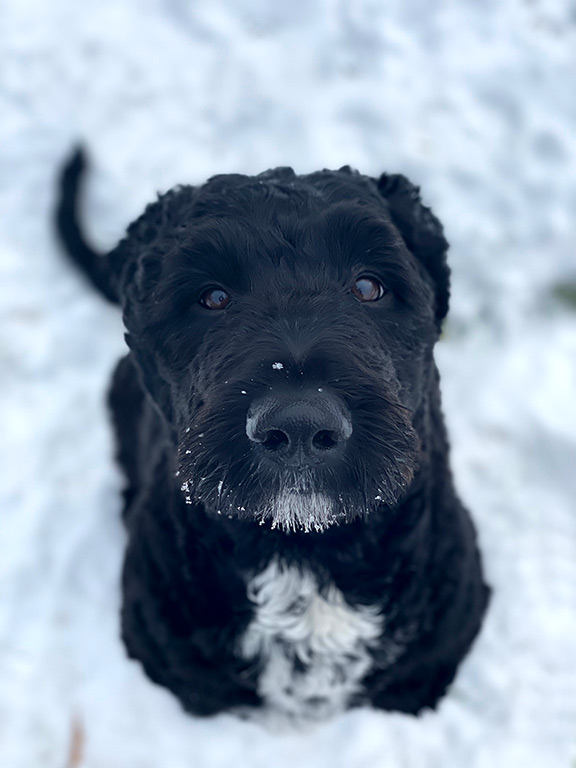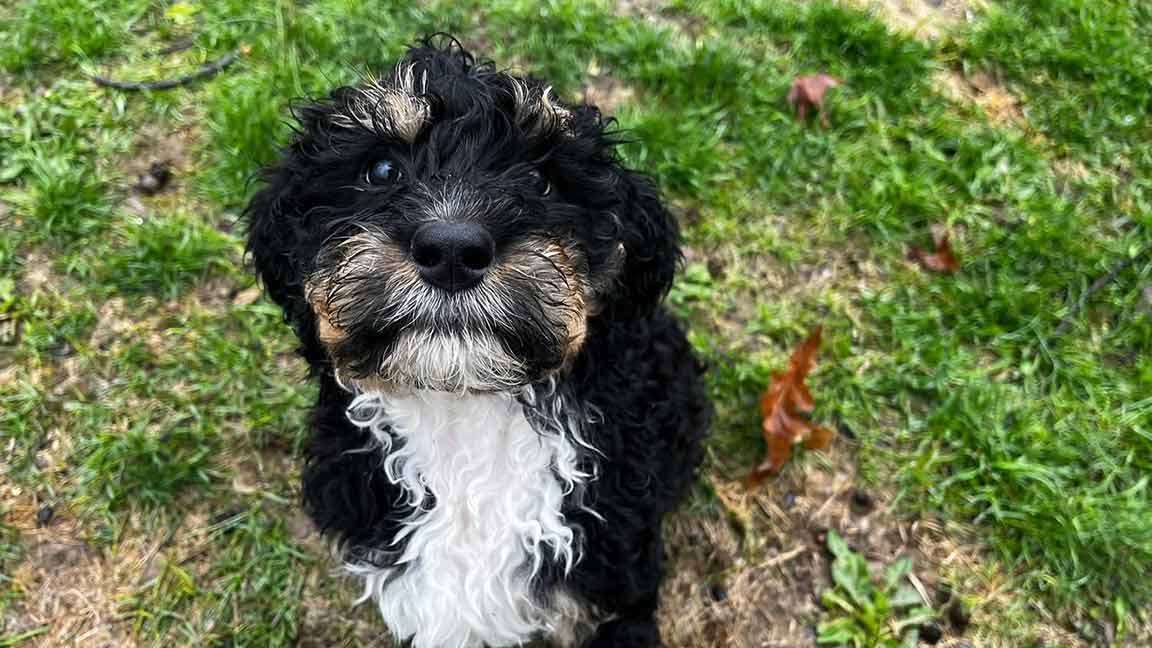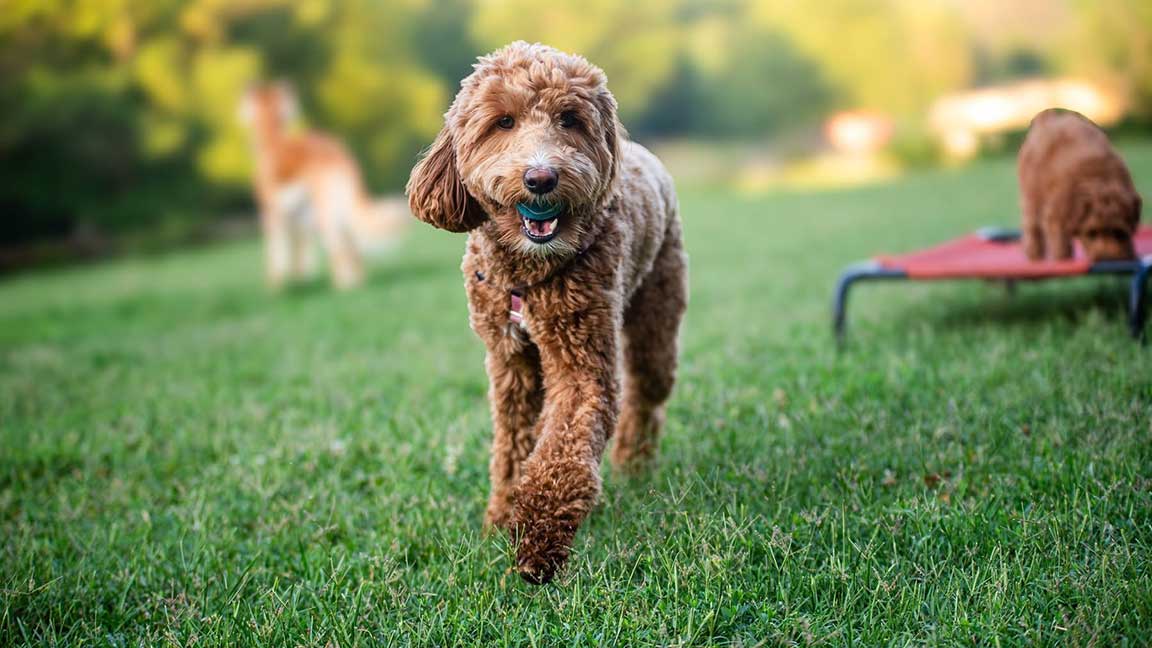
Black Goldendoodle: Can Goldendoodles be Black?
Goldendoodles and other Doodle breeds have gained immense popularity recently due to their teddy bear looks and lovable personalities, low-shedding coats, and potential hypoallergenic qualities. As the breed becomes more popular, people tend to develop preferences for specific coat colors, sizes, and other appearance traits in their doodles.
Among these preferences, black Goldendoodles have emerged as a particularly sought-after variety. Black Goldendoodles are incredibly special and cute, which explains why they are so popular. Below, we’ll talk about everything you need to know about black Goldendoodles.
Origin of Goldendoodle Colors
Goldendoodles are a newer hybrid breed that is a cross between a Golden Retriever and a Poodle. Most commonly, Goldendoodles are shades of red, apricot, or cream, but many other colors are possible such as; black, brown, sable, Merle (pattern), phantom, brindle, parti, and more.
How Do Goldendoodles Get Black Coats?
So, we’ve recognized that Goldendoodles can get black coats, but how?
For black Goldendoodle puppies to be born, both the Golden Retriever and Poodle parent must carry a black coat trait. The black coat trait is dominant, which means you only need one copy of the trait for it to be expressed. The capital B in the color genetics represents the black trait. Therefore, (B/B) is two copies of the black trait and the dog is always going to pass at least one copy of the black trait to 100% of its offspring. (B/b) is one copy of the black trait and the dog can pass the black trait to 50% of its offspring. There is one exception – if the dog is (e/e), it blocks the expression of color and the dog is a shade of red/cream/golden. Color genetics are complex, but it is relatively easy to achieve the beautiful black color in Goldendoodles. Both parents need to be (E/E) or (E/e) and (B/B) or (B/b).
Golden Retrievers typically come in “golden” shades or colors. However, all purebred Golden Retrievers carry the double-recessive (e/e) gene, according to the Golden Retriever Club of America. This gene prohibits black pigment in their hair. However, when mixed with a dog who is (E/e) or (E/E), the recessive genes are no longer dominant, allowing the offspring to be black.
Producing a black Goldendoodle is more likely when both parents have genes for the black coat color. This color can come in any generation, as long as the parents have the correct genes.
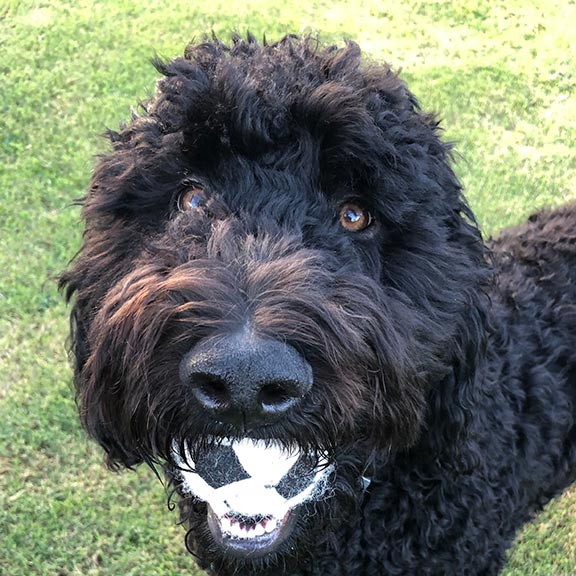 Black Labradoodles vs. Black Goldendoodles
Black Labradoodles vs. Black Goldendoodles
Labradoodles can have the same genetics as Goldendoodles when it comes to the beautiful black color genetics.
Labradoodles are a mix of Labrador Retrievers and Poodles. Labrador Retrievers’ colors can be golden, cream, brown, or black, while Poodles have various coat colors.
So, Poodles and Labrador Retrievers can both exhibit beautiful black coats, making it much easier to breed a Labradoodle with a black coat.
Goldendoodle Breed Standard
It has been a common misconception that the Goldendoodle breed does not have a breed standard since they are not purebred, unlike the parent purebred Poodles and purebred Golden Retrievers. However, the Goldendoodle Association of North America established a Goldendoodle breed standard in 2019.
GANA promotes and guides the development of the Goldendoodle to achieve breed standards while maintaining optimum health.
The breed standard recognizes all sizes of Goldendoodle and includes multiple coat colors and patterns.
Do Goldendoodles Coats Change Over Time?
You may notice slight changes to your Goldendoodle’s coat throughout its lifespan. For example, when you first get your puppy, its coat will be super soft and will likely be darker than it’s final adult coat color.
Additionally, black Goldendoodles change color slightly over time. A Goldendoodle’s black coat may lighten over time, or it may gain sprinkles of brown, silver, or white throughout adulthood. A black Goldendoodle’s coat will not change to a different color completely, but most owners will see a noticeable change in coat color over time. However, their coat will still be beautiful, even if it is ever-changing.
Do Black Goldendoodles Shed?
Poodles are non-shedding, hypoallergenic dogs. When mixed with other breeds, they make low-shedding, hypoallergenic dogs. As such, Goldendoodles are known for their low shedding, hypoallergenic coat. This makes them a popular choice for people with allergies or those who don’t like to deal with shedding.
While Goldendoodles are generally low-shedding, no dog breed is 100% non-shedding, and neither are humans. Some Goldendoodles may still shed a little, especially during seasonal changes or if they have inherited more of the Golden Retriever’s coat traits. However, their shedding is typically minimal compared to breeds that are typically shedders.
Black Goldendoodles are no different. The color of the coat does not impact the amount of shedding; it’s primarily determined by the individual dog’s genetics, primarily the number of furnishing genes it carries. A dog needs to inherit two furnishing genes to be considered as a non-shedding dog.
Most Goldendoodle owners don’t notice any shedding, but there is no guarantee that they will not shed. However, a black Goldendoodle’s hair may be more noticeable on lighter-colored furniture.
Grooming
Goldendoodles do not have fur like other dog breeds; their coat is hair, similar to our own hair. This means that dog owners need to care for their Doodles’ hair similarly as they take care of their own hair. Doodle hair can easily become matted and tangled.
It is recommended that puppies get brushed daily with a slicker brush followed by a metal comb to help eliminate mats and tangles. It also teaches your puppy that grooming is a routine event. This will allow your puppy to get used to being brushed and will allow the process to be easier in the future.
When a Goldendoodle becomes an adult, breeders and groomers recommend brushing their hair twice a week to prevent matting.
Brushing a Goldendoodles teeth is also recommended, as doing so can prevent dental disease, improve breath, allow for early detection of oral health problems, save you money, and prevent systemic diseases. It is recommended to have a regular teeth brushing schedule for your Doodle.
Cutting a black Goldendoodle’s toenails can be notoriously difficult. However, they need to be cut monthly, so it is not something you can avoid.
Since a lot of black dogs also have dark black toenails, it can be challenging to see the quick, which is the dog’s blood and nerve supply. Cutting the quick or even cutting too close to the quick can be a very painful experience for your dog and a very messy experience for you.
Make sure that you understand how to cut a dog’s dark-colored toenails before attempting to do so. There are plenty of videos and tutorials that could be of use. If, after seeing a few tutorials, you still don’t feel comfortable trimming your dog’s toenails, get a professional to do it.
To allow clipping toenails to be easier for both you and your groomer, you should massage/play with your puppy’s toes on a regular basis. This will allow your puppy to be more comfortable and used to their paws and toenails being touched. Doing this will allow the task of toenail clipping to be much easier.
Cost of Black Goldendoodles
Goldendoodles are a more expensive dog breed. The price of buying a Goldendoodle is anywhere from $2,000 to $5,000 dollars. But, many would agree that having a Goldendoodle who is your best friend and sidekick is worth every penny.
Additionally, caring for a puppy can cost a lot of money. Research shows that the average dog parent may spend anywhere from $610-$3,555 per year on their dog, which averages to $40-$290 per month. It’s vital for dog owners to be aware of the costs of vet visits, grooming, toys, etc., before acquiring a dog.
Coat Types of Goldendoodles
The genes in a Goldendoodle are responsible for determining all aspects of the dog’s coat and appearance.
Goldendoodles can have the following coats:
- Straight coat – either long and fluffy or short and flat
- Wavy coat
- Curly coat
All but the straight coat that is short and flat have the possibility of being non-shedding, and therefore, being hypoallergenic. However, this does depend on whether or not two furnishing genes are present.
Health and Temperament vs. Color and Coat
Obviously, breeders want you to be happy with the puppy you receive. However, most breeders will prioritize health and temperament instead of color or aesthetic traits. Breeding for specific traits is very complex and a responsible breeder will not prioritize a litter’s color outcome over temperament, health, and structure.
Responsible breeding practices and a focus on the dog’s overall well-being should always be the priority when choosing a new furry companion.
Goldendoodle breeders will still do their best to match you with a Doodle that best fits your preferences. If having a black Goldendoodle is your goal, you will likely just need to be patient waiting for your wish to be granted.
Creative and Fun Black Goldendoodle Names
Black dogs can have super creative names that fit with their coat color.
Some fun and creative black Goldendoodle names are:
- Midnight
- Hershey
- Oreo
- Shadow
- Pepper
- Bear
- Domino
No matter the color, Goldendoodles have “Golden” personalities.
Goldendoodles are one of the best and friendliest breeds to choose if you have a family member that has allergies and you need a dog that will be compatible for those needing a low to non-shedding coat. You will end up adoring your Goldendoodle’s amazing and sweet personality as well as the lack of hair left around the house.
If you love the beautiful and special black coat color, then a black Goldendoodle might be worth the wait. Goldendoodles are a loving, patient, and adorable breed, making them a fantastic family pet.
However, as mentioned earlier, the genetics involved in coat color inheritance can make it challenging to produce black Goldendoodles consistently.
Ethical Breeding for Goldendoodle Colors
Responsible breeders prioritize the health and well-being of their dogs above all else. They carefully plan their breeding programs to produce healthy and well-tempered puppies rather than focusing solely on specific coat colors. While black Goldendoodles are desirable, prospective dog owners should be patient and work with reputable breeders who prioritize the welfare of their dogs and strive for responsible and ethical breeding practices.
It’s essential for individuals looking to adopt or purchase a black Goldendoodle to do thorough research, reach out to reputable breeders, and be willing to wait for the right opportunity to bring a new furry friend into their home. A dog’s color is just one aspect of its characteristics and finding the right fit in terms of temperament and compatibility should always be the main consideration.
FAQ
Are black Goldendoodles rare?
Not Really but since most breeders don’t breed this color it can seem that they are harder to find. Black Goldendoodles are relatively rare compared to other colors just because most breeders focus on the other colors. Their unique coat color often comes from recessive genes.
What is the temperament of a black Goldendoodle?
Black Goldendoodles are just as friendly, loving, and intelligent as any other Goldendoodle. They make wonderful family pets with their gentle and playful nature.
What is the rarest Goldendoodle color?
The rarest Goldendoodle color is often considered to be blue or silver, but unique patterns like parti or merle can also be quite uncommon.
What is the most expensive Goldendoodle color?
The price can vary, but colors like chocolate or merle often fetch higher prices due to their rarity and the specific breeding required. Learn what to expect from Goldendoodle pricing as you begin to shop.
Do black Goldendoodles turn silver?
Sometimes black Goldendoodles can develop silver or gray hues as they age, depending on their genetics.
What is the lifespan of a black Goldendoodle?
A black Goldendoodle typically enjoys a lifespan of 10 to 15 years, just like Goldendoodles of other colors. Proper care and a loving environment can help them live a long, happy life.
that I could take her/him on a plane and that he/she have the temperment to be a therapy dog. My last dog was a 120 pound Bernese Mountain Dog who worked as a therapy dog. That experience was very rewarding and i wanted to continue that way of giving back to the.community.
Camille is adjusting to her new home wonderfully. She didn't eat anything the first 24 hours, just drank a little water. But after that it's obvious she loves her PawTree kibble. The first 36 hours she was very calm. She liked her little crinkly lamb and her red bone. But today she's gotten playful and bouncy. She has a ball as big as her head that she likes to chase and chew on. She's only had 1 accident in the house which happened because we weren't paying attention to her. She loves everybody but it's clear I, Mommy, am her favorite. She follows me wherever i go. I got a soft carrier that I can take on a plane. I had errands to do today so she went with me, including the grocery store. She just slept in her carrier in the grocery cart. No one even knew she was there. She readily gets in her crate. We have to close the latch because she instantly found out how to open it.
She has the perfect personality for being a therapy dog. She'll let anyone hold her. I took her to her vet who declared her "perfect."
It's clear that during her first 8 weeks with Fox Creek Farm she was loved and well taken care of. I chose Fox Creek because of the number of years they have been breeding goldendoodles and have been choosing dogs to breed that will forward a healthy line. They answered all of my questions and never got annoyed with the number of times I contacted them. Their website was very extensive with lots of advice on raising the dog. The breeder of my last dog had no interest in him after I picked him up, not even with health problems he developed. I know that the folks at Fox Creek want to know the good and the bad of their dogs and will incorporate information to breeding subsequent litters.
To tell the truth, I had concerns that
Fox Creek promoted a particular brand of dog food. The Paw Tree company is a multi level marketing business and Fox Creek makes money when their clients buy their products. But that fact didn't cancel my confidence in their commitment to each dog and to further the health of the breed. I will have my vet evaluate the quality of Paw Tree ingredients. I'm sure that Fox Creek has reason to trust Paw Tree, but they are not the only company making good products for dogs. Ultimately, I will follow the advice of my vet.
The bottom line is I feel really good about having chosen Fox Creek as the breeder of my dog. They are not just a business making money from breeding dogs. There are companies who charge less for their puppies. But my confidence in the breeder of my baby is worth the price I paid. I am fortunate to be able to afford the price and I can't put a price on knowing that whatever happens in the health of my dog, Fox Creek has done all that's possible to create the
best there is of the breed.
She is the smartest, most pleasant dog we have ever owned. She wants to please and she learns so fast! She has filled the hearts of these empty nesters. 🐾💖
Carl V,
Carmel, IN
